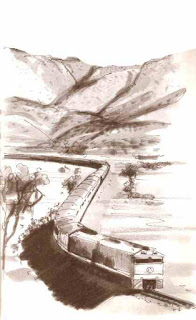The Ghan, running from Adelaide to Darwin, is our most luxurious train. Its forerunners were the Afghan camel drivers. In 1840, drivers and their animals were introduced to transport goods, even pianos and furniture, to settlements of the great dry inland. They were brought into the country from Afghanistan because their home country’s climate was as hot and dry as Australia's. The camel drivers’ nationality was shortened to ‘Ghan’ and the route has been called by this name ever since.
In 1860 24 camels were imported for the Burke and Wills expedition that was endeavouring to cross Australia from Melbourne to the Gulf of Carpentaria. They reached the fringe of the Gulf in February 1861. However, Burke and Wills died on the way back south on the banks of Cooper Creek, just by a tree that has the word "dig" carved in its trunk. Provisions had been buried there for the explorers, but they failed to dig and died of malnutrition. This tree is now known as the Dig Tree and you can still read the inscription today.
The Ghan is a modern, fast passenger and freight train going all the way to Darwin. The section of the line from Alice Springs to Darwin is proving to be a great tourist attraction. The journey starts in Adelaide, South Australia. An important station midway on the route is Alice Springs, known as The Alice. It was named after Lady Alice Todd, the wife of Sir Charles Todd who was in charge of the building of the Overland Telegraph Line. The station at the northern end of the line is Darwin, named by the Captain of HMS Beagle in honor of Charles Darwin.
◆ Technology by Ty Buchanan ◆
●




